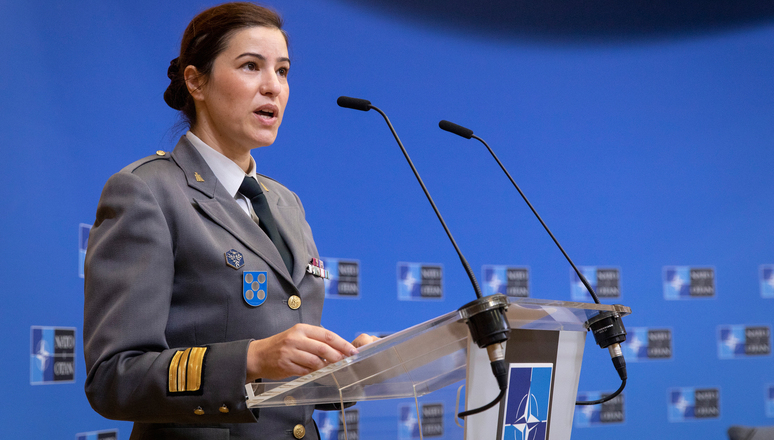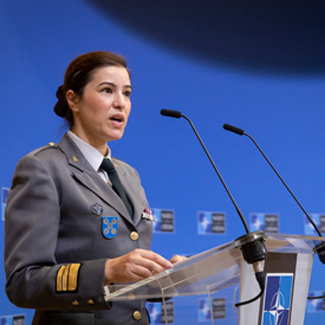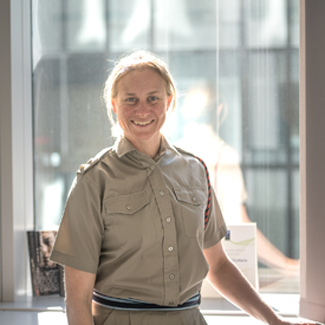NATO, as a political and military alliance, has a robust institutional framework comprised of dedicated civilian and military staff. There are several tools utilised by NATO military staff and Allied armed forces that ensure that gender perspectives are effectively integrated into all analysis, planning, missions and operations.

NATO’s Policies on Women, Peace and Security (WPS), Conflict Related Sexual Violence (CRSV) and Prevention and Responses to Sexual Exploitation and Abuse (SEA), and their corresponding Military Guidelines, are expressions of this political will and military readiness. Meet two of the people who dedicate their work to integrating the gender perspective on the military side at NATO:
 Lieutenant-Colonel Diana Morais holds a master’s degree in Military Engineering and is currently a PhD candidate in Gender Studies. Lt. Col. Morais has held several appointments as an Army Engineer officer, such as platoon and company commander. In June 2017, Lt. Col. Morais applied and was elected Deputy-chair of the NATO Committee on Gender Perspectives (NCGP). Two years later, she was elected for the Chair position and, in June 2021, following the two-year period of co-sharing, she took over as NCGP Chair.
Lieutenant-Colonel Diana Morais holds a master’s degree in Military Engineering and is currently a PhD candidate in Gender Studies. Lt. Col. Morais has held several appointments as an Army Engineer officer, such as platoon and company commander. In June 2017, Lt. Col. Morais applied and was elected Deputy-chair of the NATO Committee on Gender Perspectives (NCGP). Two years later, she was elected for the Chair position and, in June 2021, following the two-year period of co-sharing, she took over as NCGP Chair.
 Lieutenant-Colonel Katherine Prudhoe has a background in Human Security and Information Operations, and comes from the British Army unit, 77 Brigade, where she trained soldiers from African Union Mission to Somalia (AMISOM) and NATO partners deploying on UN missions. She has also been deployed to Iraq, Turkey and Bosnia. She has combined her Reservist military career with a civilian career running large digital change projects for private sector organisations. Currently she serves at the IMS Office of the Gender Advisor (IMS GENAD).
Lieutenant-Colonel Katherine Prudhoe has a background in Human Security and Information Operations, and comes from the British Army unit, 77 Brigade, where she trained soldiers from African Union Mission to Somalia (AMISOM) and NATO partners deploying on UN missions. She has also been deployed to Iraq, Turkey and Bosnia. She has combined her Reservist military career with a civilian career running large digital change projects for private sector organisations. Currently she serves at the IMS Office of the Gender Advisor (IMS GENAD).
Why should NATO integrate the gender perspective on the military side of NATO?
Lieutenant-Colonel Diana Morais: The increasing complexity of the strategic environment requires an in-depth understanding of how new and more advanced patterns of warfare affect women, men, girls and boys differently. Integrating gender perspectives into the analysis and planning of our operations will give a deeper understanding of the societies in which we operate, as well as the modus operandi used by our adversaries. This will improve the Alliance’s ability to recognise and respond to threats and challenges. It is also crucial that the Alliance’s armed forces, when recruiting, ensure the full participation of both men and women.
What are NATO forces doing in taking the gender dimension into account at all stages?
Lieutenant-Colonel Diana Morais: We have been providing guidance to the Military Committee in four different lines of effort. First, development of doctrine: making sure we identify the fundamental principles by which the military forces guide their actions. Second, education and training: recognising the need to integrate gender perspectives in all military education and training for all ranks and positions. Third, leadership development: making sure gender perspectives are integrated in the professional development of all military leaders. And fourth, resources: recognising that it requires the adequate resources to accomplish an assigned mission or to integrate gender perspectives across the Alliance.
Lieutenant-Colonel Katherine Prudhoe: NATO has a network of Gender Advisors to ensure that gender perspectives are considered in military planning, from the strategic level to military planning on operations in Kosovo and Iraq. The Nordic Centre for Gender in Military Operations (NCGM) provides training courses on the gender perspective. As the gender perspective is a crosscutting theme, all Centres of Excellence consider gender in relation to their specialisation, for example Counter-Terrorism and Gender, or Hybrid Threats and Gender.
What is the greatest challenge in integrating the gender perspective on the military side of NATO?
Lieutenant-Colonel Katherine Prudhoe: The greatest challenge is making the gender perspective relevant to people who are new to the subject. It needs to be accepted as something that adds value to all military considerations, including the planning and execution of military operations. For those (including me) who attended military training over 20 years ago, the gender perspective was not embedded into traditional military training, so this subject needs to be added at all levels of training to make sure that the gender perspective for all key topics is understood.
What does a typical day in your role look like?
Lieutenant-Colonel Diana Morais: The NCGP normally meets in plenary session three to four times a year. One of these sessions is the NCGP Annual Conference, held at NATO Headquarters, which gathers all of the national delegates and subject matter experts coming from the capitals. The main objective of the annual conference is to prepare recommendations to present to the Military Committee, but the conference also allows for the sharing of best practices and expertise in integrating gender perspectives between member states and partners. This year, we are planning to hold our Annual Conference during the first week of October, where we will be discussing the new Strategic Concept and the integration of gender perspectives in the conflict in Ukraine.
Lieutenant-Colonel Katherine Prudhoe: As I work at the strategic level, my role is to ensure the gender perspective is considered in military guidance for new policies. In order to achieve this, I attend senior leadership meetings and meetings of the military committee in order to flag when the gender perspective needs to be considered. I also work with Allied and partner nations and institutions. For example, I am currently working with the European Union Military Staff on military recommendations of the nexus of climate, gender and security. I work with the NCGP to run the annual conference, and with Centres of Excellence to run deep dive sessions for those involved in policy-making.
What drives you to work on gender in security and defence?
Lieutenant-Colonel Diana Morais: The fundamental thing that drives me to work on gender is the necessity to make the defence sector more effective. Meeting the complex demands of conflict requires a diversity of skills, experiences, perspectives, and approaches and we cannot afford to exclude 50% of the population – women – when recruiting or staffing our missions. Furthermore, differences in gender roles and stereotypes impact everything we do, and our adversaries are capitalising our own misconceptions and biases. What gender perspective means in building or maintaining peace is to challenge the military to adapt their response to the societies they seek to protect, by changing the way we plan and execute our missions and operations.
Lieutenant-Colonel Katherine Prudhoe: I am motivated to work in this field because I think the gender perspective is essential to understanding modern conflict. Conflict is no longer taking place on a Napoleonic battlefield. Modern conflict is taking place on social media, and in towns and cities among the civilian population. We need to consider how men, women, boys and girls are affected differently both as victims or perpetrators of conflict. Conflict vulnerabilities, such as CRSV, and conflict drivers, such as terrorism or state adversaries, need to be viewed through a gendered lens to understand how to better plan and respond.
